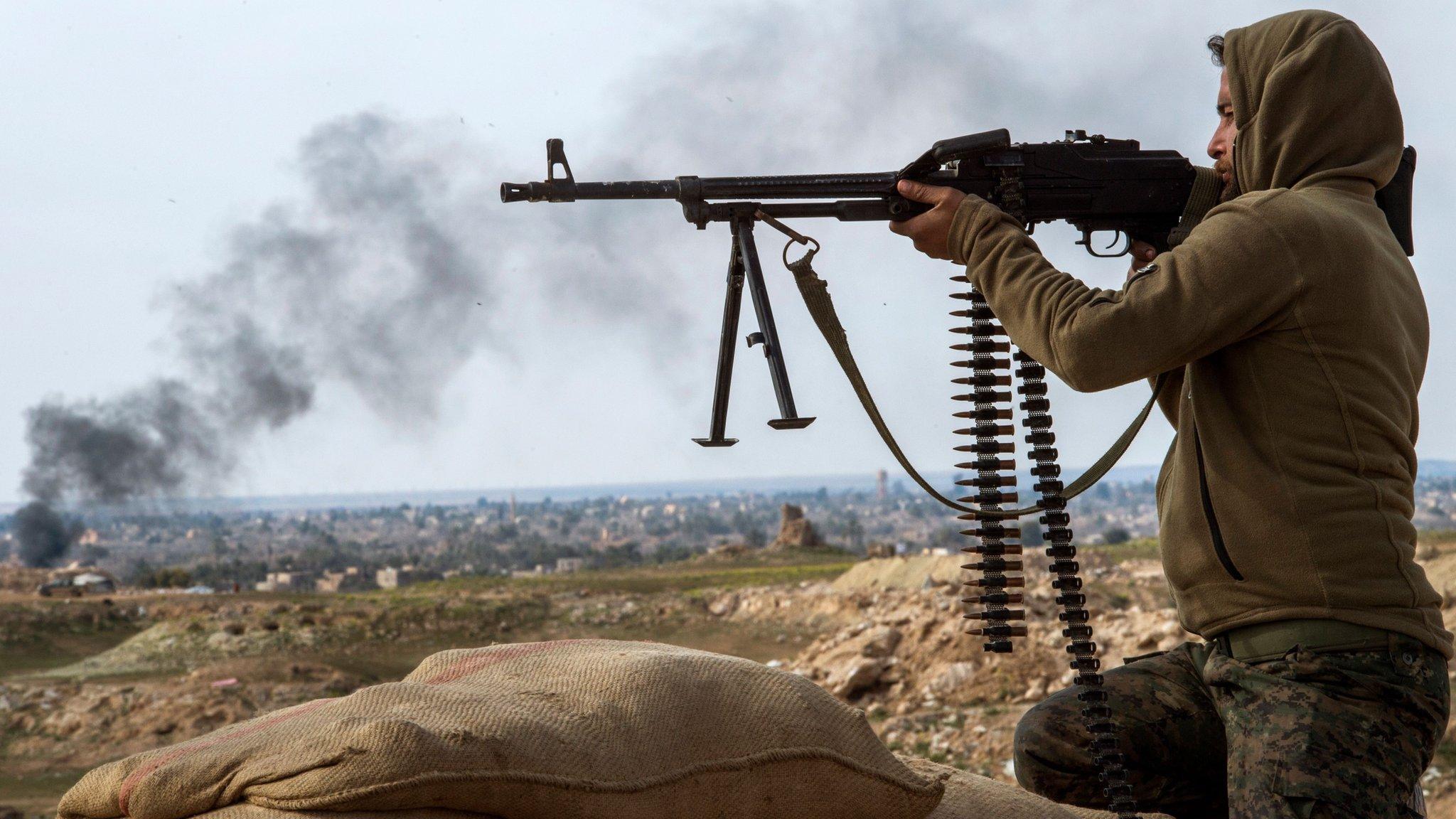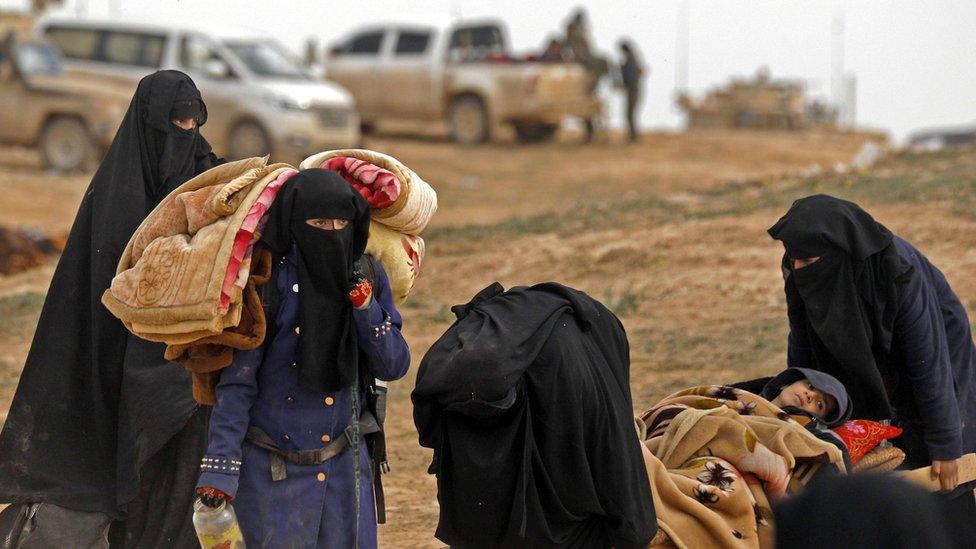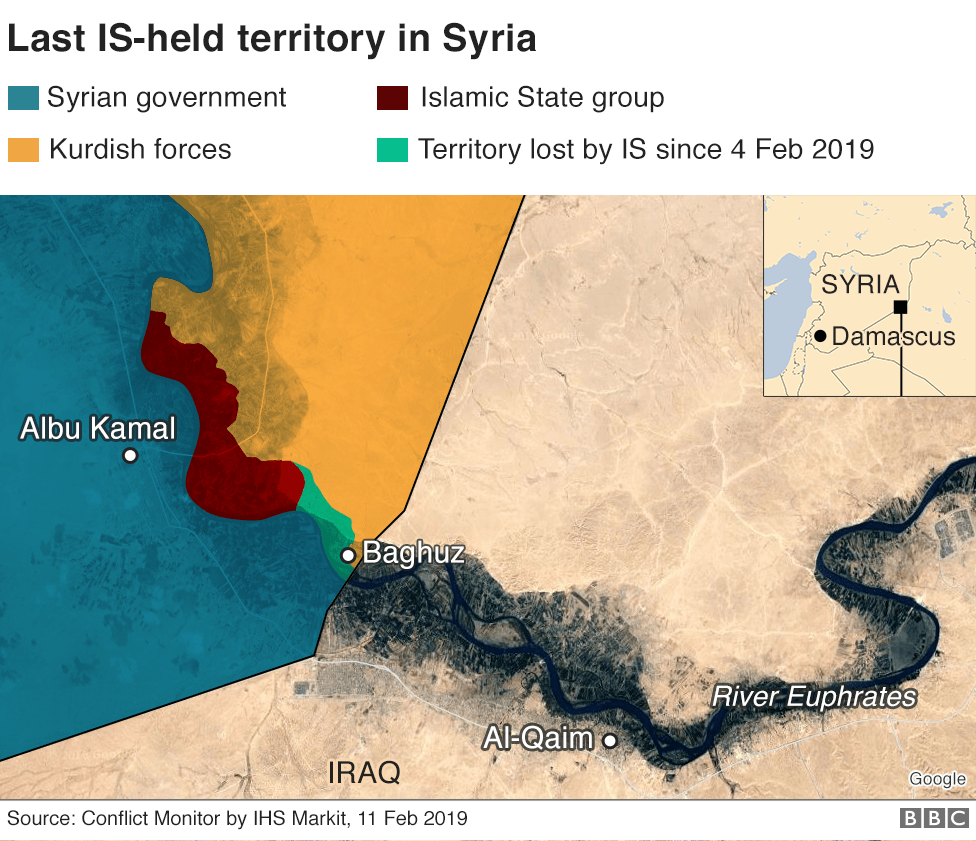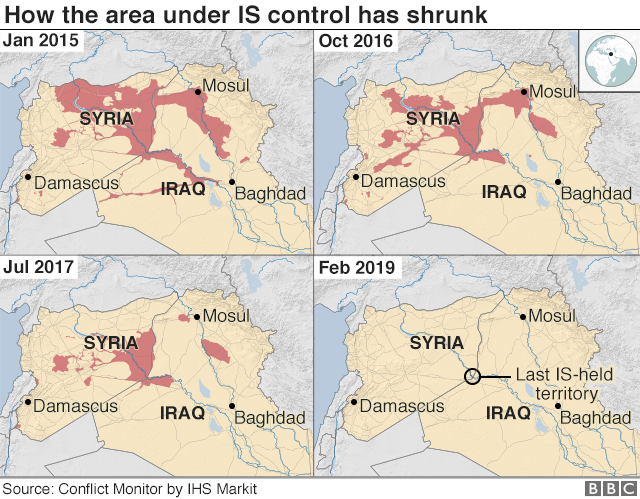US-backed Syrian fighters battle to clear final two IS villages
- Published

Fighter from the Syrian Democratic Forces (SDF) say they are facing fierce resistance
US-backed Syrian fighters are clearing Islamic State (IS) militants from the last two villages the jihadist group controls, military officials say.
The Kurdish-led Syrian Democratic Forces (SDF) alliance launched an assault at the weekend on Shajalah and Baghuz, near Syria's border with Iraq.
The last militants remaining there are reportedly retreating and hiding among the local population.
Some have sought to escape among the hundreds of civilians fleeing on foot.
What is happening to those leaving?
Among the thousands of people who have fled the area, there are hundreds of foreign IS fighters and their families. They have handed themselves over to the SDF.
Maj Gen Christopher Ghika, a spokesman for the US-led multinational coalition supporting the alliance, said that some of the wives of IS fighters had sustained gunshot wounds while fleeing.
"These utterly despicable and ghastly acts further illustrate their barbaric nature and desperation as [IS] struggles to hold on to their remaining territory," he said.

Hundreds of women, many of them wives of IS fighters, have fled Baghuz in recent days
The wives have been taken to SDF-run camps for displaced people. Among them are many foreign nationals, including the British teenager Shamima Begum, who ran away from her home in 2015 to join IS.
Ms Begum, 19, told the Times newspaper, external on Wednesday that she had no regrets but wanted to come back to the UK as she was nine months pregnant.
Why is the battle taking so long?
SDF spokesman Adnan Afrin said militants still wanting to fight were putting up "significant resistance" in an attempt to slow the clearance operation.
"There are many tunnels in Baghuz now. This is why the operation is dragging on," he told AFP news agency. "There are many suicide bombers attacking our positions with explosives-laden cars and motorbikes."
US-led coalition aircraft are carrying out strikes on IS positions inside the village and special forces are on the ground to advise SDF commanders.


What happens next?
Five years ago IS controlled 88,000 sq km (34,000 sq miles) of territory stretching from western Syria to eastern Iraq, proclaimed the creation of a "caliphate", imposed its brutal rule on almost eight million people and generated billions of dollars from oil, extortion, robbery and kidnapping.
Now, an estimated 1,000 militants and civilians are believed to be surrounded inside about 1 sq km of land in the Middle Euphrates River Valley.
Is this the end for Islamic State?
When Shajalah and Baghuz have been cleared, which could happen this week, US President Donald Trump is expected to declare the "defeat" of IS.
However, the UN's counter-terrorism chief has warned IS remains a global threat.
Vladimir Voronkov said on Monday that IS was evolving into a covert network, external with up to 18,000 fighters still operating in Syria and Iraq and affiliates in a number of other countries in Africa, the Middle East and Asia.
In Iraq, sleeper cells active in sparsely populated rural areas are seeking to undermine government authority, create an atmosphere of lawlessness and sabotage societal reconciliation, according to the UN.
Gen Ghika stressed on Thursday that the end of the "physical caliphate" did not signal the end of the US-led coalition's campaign against members of IS. "We will pursue them until that threat is eliminated," he said.


What's happened to the foreign fighters?
More than 40,000 foreign men, women and children from 110 countries may have travelled to join the conflicts in Syria and Iraq. They include 5,000 Europeans and 250 Americans.
US-led coalition officials have said tens of thousands of IS militants have been killed, but they have been unwilling to speculate on the number of foreigners.
However, a recent UN report said up to 3,000 IS foreign fighters of various nationalities were reportedly still operating in Iraq and Syria, external.
Interview with so-called 'IS Beatles' duo
There are believed to be another 1,000 foreign fighters of various, sometimes undetermined, nationalities under arrest in Iraq, according to the report.
The SDF has captured about 800 foreign fighters, external, and is holding 400 to 500 women and more than 1,000 children associated with foreign fighters.
The US has called for the repatriation of the SDF's captives. However, their home countries have raised concerns about bringing hardened IS members back and the challenges of gathering sufficient legal evidence to support prosecutions.
This may become a serious issue, because after Mr Trump announced the US would begin withdrawing troops from Syria in December SDF officials warned that the alliance might be forced to release the foreigners currently being held.
More than 5,000 foreign fighters, including 1,500 Europeans, had returned to their home countries by late 2017, external. The UN has expressed concern about them becoming active again on release from prison or for other reasons. It has also said radicalised women and traumatized minors may pose a threat.